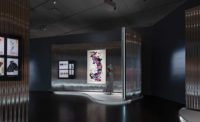Roth + Sheppard Architects
Denver, Colorado
'We had to . . . figure out ways to make the merchandise look like art. Now many people walk into the lobby and think the store is the first gallery.' ' Jeff Sheppard, Roth + Sheppard Architects
Established more than 26 years ago, Roth + Sheppard Architects have a bunch of retail projects in their portfolio — “just cool spaces that seemed to work,” says Jeff Sheppard, coprincipal of the Denver-based firm. His design of the gift shop at Daniel Libeskind’s Denver Art Museum wasn’t based on a gut sensibility, though. Instead, he and his team took a scientific approach to the design in order to directly impact sales. According to consultant Andoniadis Retail Services, the museum store’s sales were substantially lower than those of other museums’, says Sheppard. “That was an indicator that maybe something wasn’t working right.”
After conducting a relocation analysis process, the firm determined that visitors were ignoring the store because it was hidden under the stairs in the lobby that led to the museum’s galleries. The spot where the shop would get the most attention appeared to be an empty space adjacent to the museum’s entrance, where a café had been planned but never installed.
Sloping, sculptural Libeskind-designed walls slice through this dynamic space, forcing the architects to buck the prevailing strategy, which is to put as much merchandise as you can on the walls. “We had to rethink that to figure out ways to make the merchandise look like art,” says Sheppard. “[But] we want you to touch it and buy it, even though it looks like art.”
With Paco Underhill’s Why We Buy: The Science of Shopping (Simon & Schuster, 2000) serving as inspiration, the architects made deliberate choices every step of the way — and achieved their goal. The project was completed in November 2009. According to data compiled by the museum, revenues increased 25 percent between calendar years 2009 and 2010, and, in the first quarter of fiscal year 2011, 29 percent of the museum’s visitors entered the museum shop, an increase over the national “capture rate” of 17 to 22 percent.
Visitors now pass through a doorless threshold next to the ticket counter, where they are given space to get a sense of the store without being bombarded by merchandise. The most profitable item — jewelry — is at a striking, centrally located counter opposite the children’s area. Columns of merchandise, only one of them structural, inspire a procession through the shop, where even gift cards are arranged on a sloping wall like a mosaic.
When the unused room was initially tapped for the new location of the store, Sheppard was wary. “In a Libeskind building, there’s a lot going on with the structure and geometric interplay,” he says. Maybe this was an intentional void, a place for people to rest their eyes? But the museum insisted that this wasn’t the case. Now, says Sheppard, “many people walk into the lobby and think the store is the first gallery.”
Architect:
Roth and Sheppard Architects
1900 Wazee Street, Suite 100.
Denver, Colorado 80202.
Phone: 303.534.7007
Fax: 303.534.7722
Location:
100 W 14th Ave Pkwy Denver, CO 80204
Completion Date:
November 2009
Gross square footage:
4936 sq.ft. Store + Café
PeopleOwner: Denver Art Museum Architect: Personnel in architect's firm who should receive special credit: Project Architect: Tim Politis AIA Designers: Christopher Keast, Adam Harding Architect of record: Jeffrey L. Sheppard, AIA Engineer(s): Electrical: BCER Engineering- Justin Butler - jbutler@bcer.com 303.442.7400 Mechanical: Beaudin Ganze Consulting Engineers – Tyler Seals - mtseals@bgce.com 303.278.3820 Consultant(s) Millwork: High Country Millwork – Marc Sagrillo - msagrillo@highcountrymill.com 303.532.2583 Custom Lighting: Urban Fabrications – Doug Brown – doug@urbanfabrication.com 303.720.3363 General contractor: NCI Norkoli Construction – Bill Norkoli – bnorkolinci@comcast.net 303.617.1535 Photographer(s): Paul Brokering - paul@pb5280.com 303.825.5280 CAD system, project management, or other software used: |
ProductsStructural system Windows Glazing Glass Channel: Frosted Film for glass: 3M “28% Milky Milky” Hardware Brackets: Marlite Visplay Interior finishes Suspension grid: Cabinetwork and custom woodwork: Paints and stains: Plastic laminate: Solid surfacing: Floor and wall tile: Resilient flooring: Furnishings Lighting Downlights: Plumbing Other unique products that contribute to sustainability: Free standing retail fixtures and displays integrate with the existing architecture creating a consistent aesthetic enhancing the existing dynamic spatial qualities as well as the new interventions. By using free standing fixtures to spatially define the interior, all existing interior walls remained, thus demolition, dust, noise and new cladding materials were kept to a minimum, reducing the material usage and waste. Add any additional building components or special equipment that made a significant contribution to this project: Allowing for a visually active and tactile experience, the merchandise within the store becomes a dynamic and evolving material that activates the space. |



























Post a comment to this article
Report Abusive Comment